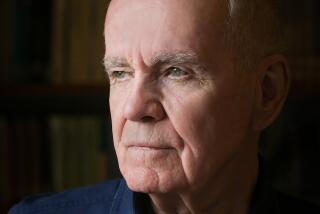Cleaning Up Victorian Clutter : WILLIAM MORRIS: A Life for Our Time,<i> By Fiona MacCarthy (Knopf: $45; 780 pp.)</i>
- Share via
‘Oh how I long to keep the world from narrowing on me, and to look at things bigly and kindly” wrote William Morris, a man whose genius had a richness and multiplicity that ranks with that of Leonardo and Goethe.
Today he is best remembered for his wallpaper and fabric designs and his seminal influence on the Arts and Crafts movement, but he was also, among much else, a furniture-maker, embroiderer and printer; a poet, novelist and pamphleteer; a socialist campaigner and factory-owner; an educationalist and environmentalist--a colossus of British culture, in fact, for 40 odd years of the Victorian era.
Fiona MacCarthy’s magnificent new biography--which leavens its deep scholarship with warmth and clarity--also illuminates Morris as a man of good-hearted generosity of spirit: not a saint by any means, and not without inner contradictions, but someone who did triumphantly manage to live his life, as he hoped, “bigly and kindly.”
There was something of the overgrown child about him. “He knew a great deal but stayed peculiarly innocent” MacCarthy believes, and this was surely one of the greatest assets of his psychological make-up. Thickset and plump, with a mop of black hair that earned him the nickname Topsy, after the similarly blessed character in “Uncle Tom’s Cabin,” he was possessed of a remarkable combination of physical and intellectual stamina (on a good day, he could write 1,000 lines of passable blank verse) and until his death in 1896 at the age of 62, he retained the capacity to change direction and focus himself passionately on mastering a new skill or activity. He was fearless and sometimes furious too, “pacing up and down a room like a caged lion to work off his superabundant energy.” When he was dying, his doctor diagnosed his disease as “simply being William Morris and having done more work than most 10 men.”
Quite where it all came from is hard to determine: There is nothing in his background, beyond a streak of distantly inherited Celtic wildness, to explain him. Morris’ father was a successful financier of conventional views who died before Morris had reached the need to rebel against him, while his mother ranks, according to MacCarthy, as “one of nature’s compulsive glossers-over.” His childhood was happy enough, and his eight siblings duly grew up to become, by and large, unremarkable pillars of respectable middle-class society. Alongside them, young William seems like a changeling, wandering in the misty romance of the Middle Ages and the magical countryside that surrounded his parents’ house in Essex.
At university in Oxford in the mid-1850s, he struck up a lifelong friendship with a similarly dreamy young man, later famous as the painter Edward Burne-Jones. Together they absorbed themselves in all things Gothic--illuminated manuscripts, stained glass, ancient churches and other manifestations of the style revived by Pugin in the 1840s--talking of a brotherhood of noble craftsmen, somewhere between the Knights of the Round Table, a monastery and a trade union. Such yearnings duly led them to Dante Gabriel Rossetti and his fellow Pre-Raphaelites, then at the acme of the Victorian avant-garde, and Morris started his career painting murals and decorating furniture under their tutelage.
Through Rossetti, he met Janey Burden, an intense gypsy beauty who sat as an artist’s model. Morris married her and they had two daughters, but the relationship was not a great success. Burden was morose, withdrawn and enigmatic; much of her time was spent as one of those undiagnosed sofa-bound invalids (like Browning’s wife Elizabeth) so common among Victorian womanhood. Morris quietly tolerated her long low-key affairs with Rossetti and the explorer Wilfrid Blunt; in return she embroidered for him and stayed loyal in her fashion. Perhaps Morris was uncomfortable with sexual intimacy: The bond of male comradeship; his fondness for his daughters, one of them tragically epileptic; and two close women friends, Burne-Jones’ wife, Georgie, and the hostess Aglaia Coronio, seem to have fulfilled his emotional needs more happily.
Throughout the 1860s and 1870s he worked with unfailing joy at his mission to redesign Victorian England, reviving traditional manufacturing skills and styles against the tide of mechanized mass-production that was flooding a newly industrialized society. Three houses with workshops attached--the Red House in Kent, Kelmscott Manor in Oxfordshire, Merton Abbey in Surrey--embodied his philosophy, theoretically at least. As MacCarthy points out wryly, the employment conditions offered by Morris and Co. were hardly models of enlightened co-operative management.
Yet although Morris became increasingly fashionable as a designer, his contemporaries knew him best as a poet. His massive pseudo-Chaucerian epic “The Earthly Paradise” was a bestseller of the mid-Victorian era and he went on to produce influential versions of the Icelandic sagas and Homer’s “Odyssey.” But none of them has worn well. As a poet, Morris failed to take himself quite seriously, MacCarthy thinks, and his sheer fertility counts against him: This is verse that can be swallowed with ease but doesn’t taste of anything much.
Where he will especially impress modern readers is in the depth and sincerity of his political commitments, based less on loyalty to a party line than to a Utopian vision of how a decent society might integrate work into life and humanity into nature. He founded the Society for the Protection of Ancient Buildings, leading an important campaign to save San Marco in Venice from crass restoration, and in the early 1880s became a pioneer socialist, speaking at rallies with revivalist fervor and penning a memorable series of pamphlets with resonant titles like “How we live and How we might Live” or “Useful Work versus Useful Toil.” Oscar Wilde, who took many of Morris’ ideas a stage further, attended his lectures wearing a large dahlia in his buttonhole. Morris himself would have thought that unmanly; his own manner was back-slapping and jolly, his aestheticism red-blooded and practical.
In the 1890s, tired of political infighting, he retreated from the front to write the lovely fantasy novel “News From Nowhere,” later influential on Tolkien and C. S. Lewis, and returned to his roots in medievalism with an edition of Chaucer that he designed with Burne-Jones. He died peacefully: One guesses he had much enjoyed his life. “I want to get Mumbo Jumbo out of the world” were virtually his last words--a fine epitaph for someone who did so much to clean up Victorian culture and a man whose embracing morality and sense of beauty remains startlingly relevant a century after his death.
More to Read
The biggest entertainment stories
Get our big stories about Hollywood, film, television, music, arts, culture and more right in your inbox as soon as they publish.
You may occasionally receive promotional content from the Los Angeles Times.










